直接引语转换成间接引语的规则
直接引语改为间接引语的变化

直接引语改为间接引语的变化1.人称的变化。
其规律为:一从主,二从宾,三不变。
具体为:(1)如果直接引语的主语是第一人称,变化时,该人称与主句的主语保持一致。
如:Mary said, “I want to forget the past.”→Mary said (that)she wanted to forget the past.(2)如果直接引语的主语是第二人称,变化时,该人称与主句的宾语保持一致。
如:He said to me,“Do you want to ask about the lab?” →He asked me if I wanted to ask about the lab.(3)如果直接引语的主语是第三人称,变化时,该人称保持不变。
如:Jim said ,“They are going to do their homework..”→Jim said (that) they were going to do their homework.2.时态的变化。
(1)如果主句是一般现在时,宾语从句原有时态保持不变。
如:Mary says,“I w ent to see the movie yesterday.”→Mary says that she went to see the movie yesterday.”(2)如果主句是一般过去时,宾语从句的时态会有以下变化(科学事实、自然规律除外)。
a.一般现在时→一般过去时b.一般将来时→过去将来时c.现在进行时→过去进行时d.一般过去时→过去完成时e.现在完成时→过去完成时。
也就是说要落后一个时态。
3.直接引语变间接引语时,指示代词、时间状语、地点状语及动词都会发生相应的变化,变化见下表。
4.各种句型的直接引语改为间接引语的方法。
(1).陈述句改为间接引语时,常用动词said, told,连词that,多被省略。
如:Ben said, “I won’t go to Marcia’s house on Friday night.”→Ben said (that)he wouldn’t go to Marcia’s house on Friday night.Lana said to me,“I’m not mad at you anymore.” →Lana told me(that)she wasn’t mad at me anymore.(2).一般疑问句常用if或whether来将其改为间接引语(选择疑问句只能用whether),常用ask来引述,可以加间接宾语。
直接引语与间接引语的转换技巧
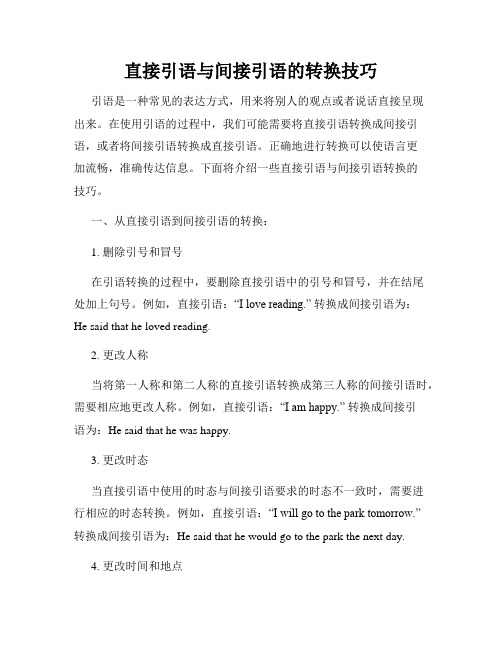
直接引语与间接引语的转换技巧引语是一种常见的表达方式,用来将别人的观点或者说话直接呈现出来。
在使用引语的过程中,我们可能需要将直接引语转换成间接引语,或者将间接引语转换成直接引语。
正确地进行转换可以使语言更加流畅,准确传达信息。
下面将介绍一些直接引语与间接引语转换的技巧。
一、从直接引语到间接引语的转换:1. 删除引号和冒号在引语转换的过程中,要删除直接引语中的引号和冒号,并在结尾处加上句号。
例如,直接引语:“I love reading.” 转换成间接引语为:He said that he loved reading.2. 更改人称当将第一人称和第二人称的直接引语转换成第三人称的间接引语时,需要相应地更改人称。
例如,直接引语:“I am happy.” 转换成间接引语为:He said that he was happy.3. 更改时态当直接引语中使用的时态与间接引语要求的时态不一致时,需要进行相应的时态转换。
例如,直接引语:“I will go to the park tomorrow.”转换成间接引语为:He said that he would go to the park the next day.4. 更改时间和地点在转换引语时,需要根据语境调整时间和地点的说法。
例如,直接引语:“I am going to the cinema tonight.” 转换成间接引语为:She said that she was going to the cinema that night.5. 更改连接词在转换引语的过程中,需要使用适当的连接词来引导引语和引语转换之间的关系。
例如,直接引语:“I think he is a good teacher.” 转换成间接引语为:She said that she thought he was a good teacher.二、从间接引语到直接引语的转换:1. 恢复引号和冒号在将间接引语转换成直接引语时,需要加上引号和冒号,并删除句末的句号。
直接引语变间接引语口诀五则

••直接引语变间接引语口诀五则1.变陈述句,去掉引号加that, 时态全向后退过;人称变化看主语,其它变化背表格。
2.变一般疑问句,去掉引号请“if”,陈述语序要记住;时态人称后状语,全都要变别马虎。
3.变特殊疑问句,直接引语去引号,原句问词作引导;陈述语序助去掉,其它变化别漏掉。
4.变祈使句,动前加to去引导,tell, ask句型套;否认祈使一样变, not就往to前靠。
5.直转间人称变,一主二宾三不变。
【特别提示】“一主”是指直接引语为第一人称变间接引语时,须与主句的主语在人称和数上坚持一致;“二宾”是指直接引语是第二人称变间接引语后需与主句的宾语在人称上一致;“三不变”是指直接引语中的代词若是第三人称,变为间接引语时则不变.直接引语变为间接引语时,若主句为过去时态,变为间接引语的宾语从句通常要将时态往后推一个,即。
如:一般现在时变为一般过去时,一般将来时变为过去将来时,现在进行时变为过去进行时,现在完成时变为过去完成时,一般过去时也变为过去完成时,等等(若直接引语为过去完成时,变为间接引语可以不变)。
另外,若直接引语中有情态动词can, may等,也应变成过去式could, might等(情态动词must可以变为had to,也可不变,should, ought to, had better 等可以不变)。
如:“I want to stay here.”he said. 他说。
如:“我想留在这儿。
”→He said that he wanted to stay there. 他说他想留在那儿。
She said, “It’s raining very hard.”他说。
如:“雨下得很大。
”→He said that it was raining very hard. 他说雨下得很大。
Jim said, “I can speak Chinese.”吉姆说。
如:“我会讲汉语。
”→Jim said that he could speak Chinese. 吉姆说他会讲汉语注意:(1) 若直接引语为客观真理,则变为间接引语时时态不变。
直接引语变间接引语的转换

直接引语变间接引语的转换:(一)如何变人称:口诀:一随主,二随宾,第三人称不更新。
'随主”是指在直接引语变间接引语时,如果从句中的主语是第一人称或被第一人称所修饰。
从句中的人称要按照主句中主语的人称变化。
如:She said. " My brother wants to go with me. " She said her brother wanted to go with her.土随宾”是指直接引语变间接引语时,若从句中的主语及宾语是第二人称。
或被第二人称所修饰。
从句中的人称要跟引号外的主句的宾语一致。
如果引号外的主句没有宾语。
也可以用第一人称。
如:He said to Kate. " How is your sister now? ” He asked Kate how her sister was then.第三人称不更新”是指直接引语变间接引语时。
如果从句中的主语及宾语是第三人称或被第三人称所修饰,从句中的人称一般不需要变化。
如:Mr. Smith said, " Jack is a good worker. " r Mr. Smith said Jack was a good worke(二)时态的变化①如果引述动词为现在时态,间接引语的动词可以保持原来的时态。
He says, " I have been writing a nove-.---- He s^ys that he has been writing a novel.He says:"that's all right."——He says that's all right.②如果引述动词为过去时态,间接引语中的时间就要往后推,即现在时间推至过去时间,过去时间推至过去的过去,将来时间推至过去将来时间。
具体变化见下表:She said:"I am a student." ------ She said (that) she was a student.(一般现在时变成一般过去时)She said: "He will go to see his friend"——She said he would go to see his friend.(一般将来时变成过去将来时)Tom said:"I am going to play basketball tomorrow." __________________________________________________ The teacher said, "You are doing。
直接引语变成间接引语注意事项
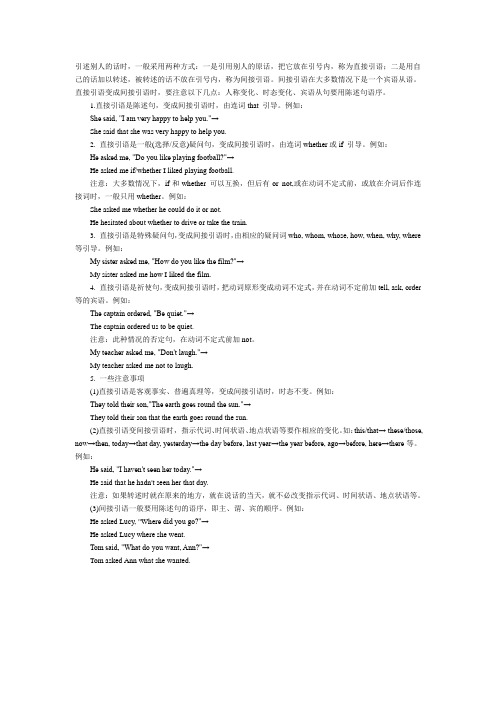
引述别人的话时,一般采用两种方式:一是引用别人的原话,把它放在引号内,称为直接引语;二是用自己的话加以转述,被转述的话不放在引号内,称为间接引语。
间接引语在大多数情况下是一个宾语从语。
直接引语变成间接引语时,要注意以下几点:人称变化、时态变化、宾语从句要用陈述句语序。
1.直接引语是陈述句,变成间接引语时,由连词that 引导。
例如:She said, "I am very happy to help you."→She said that she was very happy to help you.2. 直接引语是一般(选择/反意)疑问句,变成间接引语时,由连词whether或if 引导。
例如:He asked me, "Do you like playing football?"→He asked me if/whether I liked playing football.注意:大多数情况下,if和whether 可以互换,但后有or not,或在动词不定式前,或放在介词后作连接词时,一般只用whether。
例如:She asked me whether he could do it or not.He hesitated about whether to drive or take the train.3. 直接引语是特殊疑问句,变成间接引语时,由相应的疑问词who, whom, whose, how, when, why, where 等引导。
例如:My sister asked me, "How do you like the film?"→My sister asked me how I liked the film.4. 直接引语是祈使句,变成间接引语时,把动词原形变成动词不定式,并在动词不定前加tell, ask, order 等的宾语。
直接引语变间接引语注意事项
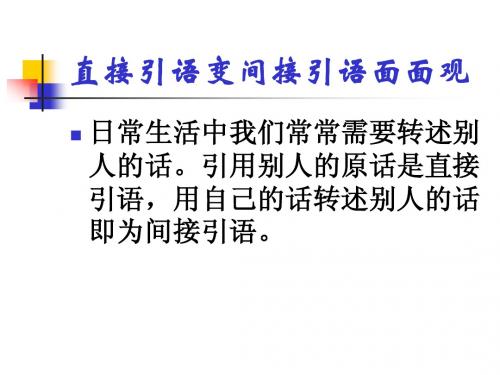
二、如何变时态: 直接引语在改为间接引语时、时态需要做相应的调整。 1) 一般现在时→一般过去时态; She said:” I am a student. ” → She said (that) she was a student. 2)一般将来时→过去将来时 She said, "He will go to see his friend.” →She said he would go to see his friend。 Tom said,” I am going to play basketball tomorrow.” → Tom said he was going to play basketball tomorrow.
Jack said. “I was doing chores when Tom came to see me” →Jack said he was doing chores when Tom came to see him.
③直接引语中有具体的过去某年、某月、某日作状语, 变为间接引语时,时态不变。如:
He said, ”I want to go swimming now. ” → He said he wanted to go swimming then.
地点状语,尤其表示方向性的, here 变 there
The teacher said ,“ You should come here at 7:00.” →The teacher said I should go there at 7:00.
练习 1. She said :”I am six years old.”
2. John said: ”I’ll be back tomorrow. ”
“直接引语”如何变成间接引语?

“直接引语”如何变成间接引语?为了配合我们的新概念课程,我们本文讲一讲直接引语和间接引语,以及它们之间如何变化的。
本文不算容易,尤其是对于刚接触的同学来说。
如果有疑问,可以留言,我会在留言里解答。
所谓直接引语,就是直接引述别人的话,不加任何改变,一般放在引号里。
如:He said, “I will learn English.”所谓间接引语,就是转述别人的话,此时需要改变一些内容,比如主语、时态、地点等。
如:He said that he would learn English.一、直接引语变间接引语时,句式变化方法如下:1. 陈述句直接引语:She said, “I will study English.”间接引语:She said that she would study English.既然转述别人的话,就不能再用人家的原话了,所以I就变成了she。
前面是said过去式,will也就变成过去时的would。
2. 一般疑问句直接引语:She asked me, “Can you speak English?”间接引语:She asked me whether I could speak English.如果别人的原话是一般疑问句,变成间接引语时记得要加上whether,然后倒装变为陈述语序。
3. 特殊疑问句直接引语:She asked me, “When can you do that?”间接引语:She asked me when I could do that.如果别人的原话是特殊疑问句,变成间接引语时不用加词,但要把倒装语序变成陈述语序。
4. 祈使句直接引语:She said to the children, “Don’t play outside.”间接引语:She told the children not to play outside.如果别人的原话是祈使句,don't 要变成not to,后面正常。
直接引语变间接引语口诀

直接引语变间接引语口诀一、当直接引语为陈述句,变成间接引语的“顺口溜”是:去掉引号加that,人称变化要灵活,时态向后退一步,状语变化按规则。
She said,“My brother doesn't want to go there.”→She said that her brother didn't want to go there.二、当直接引语为一般疑问句,变成间接引语的“顺口溜”是:去掉引号加if,陈述语序要记住,时态人称和状语,小心变化别马虎。
I asked her,“Do you study English here?”→I asked her if she studied English there.三、当直接引语是特殊疑问句,变成间接引语的“顺口溜”是:直接去引号,陈述莫忘掉,小心助动词,丢它最重要。
“What do you want?”he asked me. →He asked me what I wanted.四、当直接引语是祈使句,变成间接引语的“顺口溜”是:去掉引号要加to, ask,tell须记住,直引若是否定式,not加在to前部。
The teacher said to her mother,“Please give me the book.” →The teacher told her mother to give her the book.五、对于人称变化,要求学生们记住的“顺口溜”是:第一人称看主语,第二人称看宾语,宾语若是不存在,活用代词I,my,me。
He said to her,“Are you interested in English?”→He a sked her if she was interested in English.The teacher said,“Where have you been?”→The teacher asked me(us) where I(we) had been.六、时态对应表:直接引语时态间接引语时态一般现在时→ 一般过去时一般将来时→ 过去将来时现在进行时→ 过去进行时一般过去时→ 过去完成时现在完成时→ 过去完成时(过去完成时时态不变)情态动词也要变成相应的过去式:can could; may might; must must/had to一般疑问句whether/if 引导的宾语从句“Is this your umbrella, Mary?” asked John.John asked Mary if that was her umbrella.特殊疑问句wh-词引导的宾语从句“Mary, when will you return John asked Mary when she wouldme the book?” asked John return him the book主句动词为一般现在时或现在完成时从句动词时态不变She often says, “All men and women She often says that all men and womenar e equal under the law.”are equal under the law.主句动词为一般过去时一般现在时一般过去时“I know it,” he said.He said that he knew it现在进行时过去进行时“I’m making coffee for you all,” she said.She said she was making coffee for us all.现在完成时过去完成时“I have seen her before,” said he. He said he had seen her before.一般过去时过去完成时“I saw her last Monday,” he said.He said he had seen her the previous Monday过去完成时过去完成时“ Do you know Rick had been ill in bed.Jack asked if I knew Rick had been ill in bedfor many days till he died?” Jack asked for many days till he died一般将来时过去将来时He said: “We shall start tomorrow He said they would start the next day由直接引语转变为间接引语,下列情况时态不变:1. 不变的真理The teacher said to the students, “Water freezes when the temperature falls below 0℃.”→ The teacher told the students that water freezes when the temperature falls below 0℃.2. 经常的习惯:He said to the doctor, “I smoke two packs every day.”→ He told the doctor that he smokes two packs every day.3. 历史事件:The teacher said, “World War Ⅱended in 1945.”→ The teacher said that World War Ⅱ ended in 1945.4. 部分情态动词,如must, ought to, used to, had better等:She said to me: “You must hurry up.”→ She said that I must hurry up.练习题;1. Jack said to me, “You look worried today.”Jack told me that ___ worried ___.A. he looks…todayB. you look…todayC. we looked…that dayD. I looked…that day2. We said to her, “They’re walking through the street now.”We told her that ___ through the street ___.A. we were walking…thenB. you are walking…nowC .they were walking…then D. they walking…now3. Mr Black said, “I have walked a long way this week.”Mr Black said that __ a long way __.A. I had walked…last wee kB. he had walked…that weekC. I walked…last weekD. he has walked…this week4. The man thought, “I shall take it back tomorrow.”The man thought that __ take it back ____.A. I shall…tomorrowB. I shall…the next dayC. he should…tomo rrowD. he wo uld …the next day5. They said to us, “Are you afraid to leave this house ?”They asked us ____ afraid to leave _____ house.A. that were we…thisB. that we were…thatC. if were we …thisD. if we were…that6. Jane said, “What did he hear about a week ago?”Jane asked ____ about _____.A. that he heard…a week ag oB. what he had heard…the week beforeC. what he had herd… a week agoD. if he heard…the week ago7. She asked, “Whose house will he break into next time ?”She asked whose house ____ break into __A. will he…next timeB. would he…the next timeC. he would…the next timeD. he will…next time8. Jack said to her, “Where do you spend your holidays?”Jack asked her where ____ holidays.A. she spent herB. you spend yourC. she spend herD. you spent your9. Black asked me, “ Why haven’t you left here yet?”Black asked me why ____ yet.A. I hadn’t left thereB. I haven’t left hereC. hadn’t I left thereD. haven’t I lef t here10. The teacher asked her, “Does the sun rise in the east ?”The teacher asked her ___ the sun ___ in the east.A. if…riseB. if…risesC. whether…roseD. whether did …rise。
直接引语变为间接引语口诀

直接引语变为间接引语口诀趣味学英语系列之十四在初中英语中直接引语变为间接引语对于学生们来说也是一个难点,因为需要变化的内容很多,这儿有一个关于直接引语变间接引语的口诀,帮助大家来记忆。
直接引语变间接引语口诀:直引若是一般问,变间ifwhether连。
语序变为陈述式,时态人称相应变。
直引若是特殊问,疑问词连接记心间。
其余问题挺简单,一切只当一般问。
直引若是祈使句,谓语动词挺要紧。
toldaskedordered,根据口气来选定。
告诉人、请人、命令人,后跟to do sth.。
若是否定祈使句,not to do后边行。
直接引语变间接引语的人称变化:一主二宾三不变.直接引语的第一人称取决于主句的主语,第二人称取决于主句的宾语,第三人称一般不变。
附直接引语变间接引语的详细介绍:直接引语就是直接引用别人的话,并把它放在引号内;间接引语就是用自己的话转述别人的话,不加引号。
直接引语变成间接引语时,间接引语通常以宾语从句的形式出现。
直接引语变成间接引语时还要注意人称的变化、时态的变化、指示代词的变化、时间状语的变化及地点状语的变化。
1. 直接引语是陈述句变为间接引语的方法如果直接引语是陈述句,在变为间接引语时,由连词that引导(在口语中that常省略)。
主句中如果有say to somebody (对某人说),通常变为tell somebody (告诉某人)。
◆ He said, “I get on well with people here.”→He said that he got on well with people there.◆ Susan said, “We can finish the work tomorrow.”→Susan said that they could finish the work the next day.◆ John said to me, “I told her all about it three days ago.”→John told me that he had told her all about it three days before.【提醒注意】如果直接引语是两个并列的陈述句,变为间接引语时,第一个宾语从句前的that有时可省略,但第二个宾语从句前的that不可省略。
直接引语变间接引语的规则
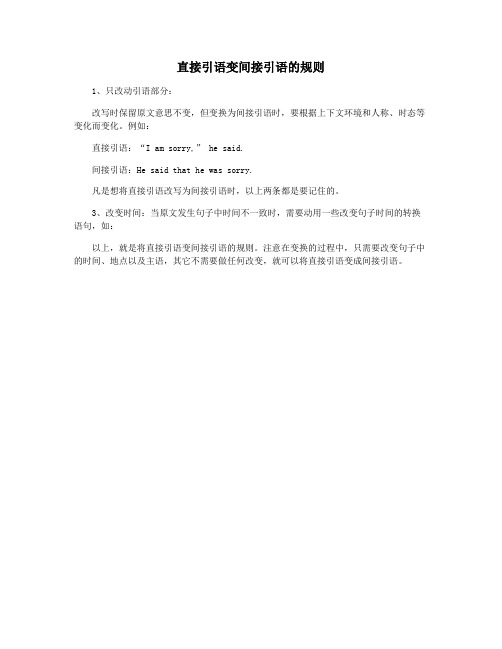
直接引语变间接引语的规则
1、只改动引语部分:
改写时保留原文意思不变,但变换为间接引语时,要根据上下文环境和人称、时态等变化而变化。
例如:
直接引语:“I am sorry,” he said.
间接引语:He said that he was sorry.
凡是想将直接引语改写为间接引语时,以上两条都是要记住的。
3、改变时间:当原文发生句子中时间不一致时,需要动用一些改变句子时间的转换语句,如:
以上,就是将直接引语变间接引语的规则。
注意在变换的过程中,只需要改变句子中的时间、地点以及主语,其它不需要做任何改变,就可以将直接引语变成间接引语。
直接引语转换为间接引语的技巧
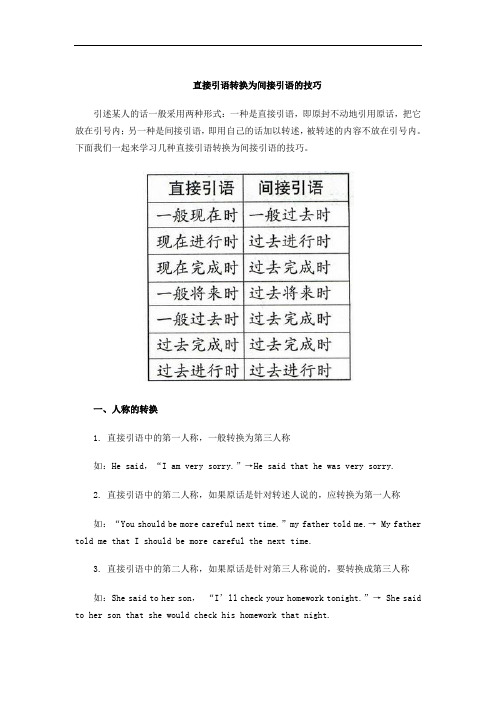
直接引语转换为间接引语的技巧引述某人的话一般采用两种形式:一种是直接引语,即原封不动地引用原话,把它放在引号内;另一种是间接引语,即用自己的话加以转述,被转述的内容不放在引号内。
下面我们一起来学习几种直接引语转换为间接引语的技巧。
一、人称的转换1. 直接引语中的第一人称,一般转换为第三人称如:He said,“I am very sorry.”→He said that he was very sorry.2. 直接引语中的第二人称,如果原话是针对转述人说的,应转换为第一人称如:“You should be more careful next time.”my father told me.→ My father told me that I should be more careful the next time.3. 直接引语中的第二人称,如果原话是针对第三人称说的,要转换成第三人称如:She said to her son,“I’ll check your homework tonight.”→ She said to her son that she would check his homework that night.4. 人称的转换包括人称代词、物主代词和名词性物主代词等如:He asked me,“Will you go to the station with me to meet a friend of mine this afternoon?”→He asked me whether I would go to the station with him to meet a friend of his that afternoon.5. 口诀巧记人称变化口诀:“一主、二宾、三不变”。
(1)“一主”指当直接引语中的第一人称变为间接引语时,要和主句中的主语在人称上保持一致。
如:He said,“I am forty.”→ He said that he was forty.(2)“二宾”指当直接引语中的第二人称变为间接引语时,要和主句中的间接宾语保持人称上的一致。
直接引语和间接引语的转换方法

直接引语和间接引语的转换方法直接引语和间接引语是英语中常见的两种引述方式。
直接引语是将某人的原话直接用引号括起来,而间接引语则是将他人的话转述出来。
在英语写作中,我们经常需要进行直接引语和间接引语的转换。
本文将介绍关于直接引语和间接引语的转换方法。
一、直接引语的转换为间接引语当我们需要将直接引语转换为间接引语时,需要注意以下几点:1. 主要变化:将引号去掉,改为使用"that"引导从句。
例如:直接引语:“I am going to the park,” she said.间接引语:She said that she was going to the park.2. 时态变化:根据引语所表示的时间改变时态。
例如:直接引语:“I am studying English,” he said.间接引语:He said that he was studying English.3. 人称变化:根据引语所表示的人称改变人称。
例如:直接引语:“I will help you,” he said.间接引语:He said that he would help me.4. 指示变化:根据引语中的指示词改变指示词。
例如:直接引语:“This is a book,” she said.间接引语:She said that that was a book.5. 修饰变化:根据引语中的修饰词改变修饰词。
例如:直接引语:“I love this beautiful city,” she said.间接引语:She said that she loved that beautiful city.二、间接引语的转换为直接引语当我们需要将间接引语转换为直接引语时,需要注意以下几点:1. 去除“that”:将从句中的"that"去除。
例如:间接引语:She said that she was busy.直接引语:“I am busy,” she said.2. 时态变化:根据引语所表示的时间改变时态。
(完整word版)直接引语和间接引语转换

语法直接引语变成间接引语时,要注意以下几点:人称变化、时态变化、宾语从句要用陈述句语序。
1。
直接引语是陈述句,变成间接引语时,由连词that 引导。
例如:She said, ”I am very happy to help you。
"→ She said that she was very happy to help you.2. 直接引语是一般/选择疑问句,变成间接引语时,由连词whether或if 引导。
例如: He asked me, ”Do you like playing football?"→ He asked me if/whether I liked playing football.注意:大多数情况下,if和whether 可以互换,但后有or not,或在动词不定式前,或放在介词后作连接词时,一般只用whether。
例如: She asked me whether he could do it or not。
3。
直接引语是特殊疑问句,变成间接引语时,由相应的疑问词who, whom, whose, how, when, why, where 等引导。
例如:My sister asked me, "How do you like the film?”→ My sister asked me how I liked the film.4。
直接引语是祈使句,变成间接引语时,把动词原形变成动词不定式,并在动词不定式前加tell, ask, order 等的宾语。
例如: The captain ordered, ”Be quiet.”→ The captain ordered us to be quiet。
注意:此种情况的否定句,在动词不定式前加not。
My teacher asked me,”Don’t laugh.”→ My teacher asked me not to laugh.5. 一些注意事项(1)间接引语一般要用陈述句的语序,即主、谓、宾的顺序.例如: He asked Lucy,”Where did you go?”→ He asked Lucy where she went。
直接引语转换为间接引语的技巧

直接引语转换为间接引语的技巧引述某人的话一般接受两种形式:一种是直接引语,即原封不动地引用原话,把它放在引号内;另一种是间接引语,即用自己的话加以转述,被转述的内容不放在引号内。
下面我们一起来学习几种直接引语转换为间接引语的技巧。
一、人称的转换1. 直接引语中的第一人称,一般转换为第三人称如:He said,“I am very sorry.”→He said that he was very sorry.2. 直接引语中的第二人称,假如原话是针对转述人说的,应转换为第一人称如:“You should be more careful next time.”my father told me.→ My father told me that I should be more careful the next time.3. 直接引语中的第二人称,假如原话是针对第三人称说的,要转换成第三人称如:She said to her son,“I’ll check your homework tonight.”→ She said to her son that she would check his homework that night.4. 人称的转换包括人称代词、物主代词和名词性物主代词等如:He asked me,“Will you go to the station with me to meet a friend of mine this afternoon?”→He asked me whether I would go to the station with him to meeta friend of his that afternoon.5. 口诀巧记人称转变口诀:“一主、二宾、三不变”。
〔1〕“一主”指当直接引语中的第一人称变为间接引语时,要和主句中的主语在人称上保持一致。
如:He said,“I am forty.”→ He said that he was forty.〔2〕“二宾”指当直接引语中的第二人称变为间接引语时,要和主句中的间接宾语保持人称上的一致。
英语语法专项:直接引语变间接引语的规则

直接引语变间接引语规则(直接引语变间接引语规则间接引语就是用自己的话转述别人的话,这叫作间接引语。
应注意:(一)时态的变化:主句中的谓语动词如果是过去时态,直接引语中的谓语动词的时态须做下列变化:一般现在时变为一般过去时(但直接引语是客观事实、永恒真理,变成间接引语时,时态不变。
例如:They told their son :”The earth goes round the sun.”They told their son that the earth goes round the sun.。
现在进行时变为过去进行时;现在完成时变为过去完成时;现在进行时变为过去进行时一般过去时变为过去完成时;一般将来时变为过去将来时。
过去完成时则不变,仍是过去完成时;过去进行时,时态不变。
(二)人称的变化:要根据句子意思改变人称,如:I--he,she; we--they等等。
学生在将直接引语变间接引语时,常常弄不清人称变化。
下面有一句顺口溜“一随主。
二随宾,第三人称不更新”。
“一随主”是指在直接引语变间接引语时,如果从句中的主语是第一人称或被第一人称所修饰。
从句中的人称要按照主句中主语的人称变化如:She said. "My brother wants to go with me. "→She said her brother wanted to go with her.“二随宾”是指直接引语变间接引语时,若从句中的主语及宾语是第二人称。
或被第二人你所修饰。
从句中的人称要跟引号外的主句的宾语一致。
如果引号外的主句没有宾语。
也可以用第一人称,如:He said to Kate. "How is your sister now?"→He asked Kate how her sister was then。
“第三人称不更新”是指直接引语变间接引语时。
如果从句中的主语及宾语是第三人称或被第三人称所修饰从句中的人称一般不需要变化如:Mr Smith said。
直接改间接引语口诀

直接改间接引语⼝诀
直接改间接引语⼝诀:⼈称,时态,状语始终变,⼀主⼆宾三不变,陈述that可省略,⼀般疑问⽤if(whether),特殊疑问去助动,以上语序为陈述,祈使句选动词(ell,ask,order,beg),将它改为不定式。
1直接引语变间接引语的⽅法
从句⼈称的变化
1)直接引语的主语是第⼀⼈称时,变为间接引语时要和主句的主语保持⼀致。
2)如果直接引语的主语是第⼆⼈称,变为间接引语时要与主句的宾语保持⼀致。
3)如果直接引语的主语是第三⼈称时,变为间接引语时⼈称保持不变。
从句时态的变化
1)如果主句是⼀般现在时或⼀般将来时,直接引语变间接引语时,从局的时态保持不变。
2)如果主句的时态为⼀般过去时,从句的时态要做相应的变化。
①⼀般现在时改为⼀般过去时;
②现在进⾏时改为过去进⾏时;
③⼀般将来时改为过去将来时。
注意:如果直接引语为客观真理、客观事实、⾃然现象时,变为间接引语时,时态不做变化。
句型的变化
1)如果直接引语是陈述句,变为间接引语时要⽤that来引导,that可省略。
2)如果直接引语是⼀般疑问句,变为间接引语时,需⽤if或whether来引导,且⽤陈述句。
3)如果直接引语是特殊疑问句,变为间接引语时,引导词就是特殊疑问词,且⽤陈述句语序。
4)如果直接引语是祈使句,变间接引语时,要将祈使句的动词变为不定。
- 1、下载文档前请自行甄别文档内容的完整性,平台不提供额外的编辑、内容补充、找答案等附加服务。
- 2、"仅部分预览"的文档,不可在线预览部分如存在完整性等问题,可反馈申请退款(可完整预览的文档不适用该条件!)。
- 3、如文档侵犯您的权益,请联系客服反馈,我们会尽快为您处理(人工客服工作时间:9:00-18:30)。
直接引语转换成间接引语的规则
引述或转述别人的话称为“引语”。
直接引用别人的原话,叫做直接引语,用自己的语言转述别人的话,叫做间接引语。
直接引语用引号标出,而间接引语不需要引号。
直接引语为陈述句。
一般疑问句,特殊疑问句,和祈使句,转换成间接引语时,句子的结构,人称,时态,时间状语和地点状语都有变化。
1. 人称的转变
直接引语转化成间接引语时,人称要根据情况作必要的变化。
She said, “I am very sorry.”
----- She said that she was very sorry.
“You should be more careful next time,” my father told me.
---- My father told me that I should be more careful the next time.
He said to his son, “I’ll check your homework tonight.”
----- He said to his son that he would check his homework that night.
2. 时态的转换
直接引语改为间接引语时,主句的谓语动词如果是过去时,从句(即间接引语部分)的谓语动词在时态方面要做出相应的变化,变成过去时范畴的各种时态(实际也是宾语从句的时态要求)。
3.时间状语,地点状语及某些对比性的指示代词和动词的变化。
4. 直接引语变成间接引语时,从句时态无须改变的情况。
1)直接引语表述的是客观事实。
科学真理和格言时,例如:
The teacher said “The earth moves round the sun.”
---- The teacher said that the earth moves round the sun.
He said, “Practice makes perfect.”
----- He said that practice makes perfect.
2) 主句的时态是一般现在时、现在进行时或一般将来时时。
例如:He often says, “I will never forget you.”
---- He often says he will never forget me.
He will say, “I have done my best...”
---- He will say that he has done his best.
3) 在同一时间范围内转述别人的话,且直接引语中含有明确的表示过去的时间状语时。
例如:
Li Ping said to me,“ I was late for school yesterday.”
---- Li Ping told me that she was late for school yesterday.(转述时间仍在当天) Tom: I have been there before.
Lily: What did Tom say?
Jin: Tom said that he has been there before.
4) 直接引语中含有when, since, while等引导的表示过去的时间状语从句,变间接引语时,从句的时态不便,例如“She said , “I went there when I was six years old.”
------ She said she had gone there when she was six years old.
5) 直接引语部分带有具体的过去时间状语时,例如:
He said, “I went to college in 1994.”
---- He told us that he went to college in 1994.
6) 直接引语中有以when, while 引导的从句,表示过去的时间时。
例如:
He said, “When I was a child, I usually played football after school.”
------ He said when he was a child; he usually played football after school.
7) 直接引语的谓语中含有would, should, might, must. used to, ought to, had better 等动词时,例如:
She said, “We should help each other.”
----- She said we should help each other.
5. 间接引语的命令,请求,劝告
直接命令,He said, “ Sit down, Tom.”
间接命令。
He told Tom to sit down.
间接命令,请求及劝告的常用句式为:“表示命令,请求,劝告的动词+宾语+不定式”。
根据语境,可选用下列动词:
advise, ask, invite, beg, implore, command, encourage, treat, forbid, order,
recommend, remind, request, tell. urge, warm ,etc.
He said, “Get your coat, Tom!”
He told Tom to get his coat.
“You had better hurry, Bill!” She said.
She advised Bill to hurry.
2) 否定意义的命令,请求等通常用not+ 不定式转述。
“Don’t play in the street, boys.” I said.
I warned /told the boys not to play in the street.
“Don’t play in the street, boys,” I said.
------ I warned /told the boys not to play in the street.
3) 表示间接命令、请求及劝告:
表示要求和忠告可用于多种方法来表示。
如:
“If I were you, I’d stop talking that medicine.” I said.
----- I advised him to stop taking that medicine.
“Why don’t you take off your coat?” He said.
------- He advised me to take off my coat.
“Would/Could you show me your passport, please?” He said. ---- He asked me to show him my passport.
------He asked to see my passport.
“You might post some letters for me,” said my boss.
----- My boss asked me to post some letters for him.。
